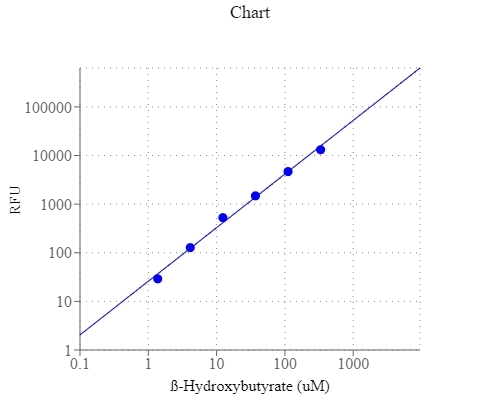Amplite® Fluorimetric Beta-Hydroxybutyrate (Ketone Body) Assay Kit
Ketone bodies are produced by the liver and used peripherally as an energy source when blood glucose levels drop. The two main ketone bodies are Beta-hydroxybutyrate (Beta-HB) and acetoacetate, while acetone is the third abundant ketone body. Normally these two predominant ketone bodies are present in small amounts in the blood during fasting and prolonged exercise. In patients who have diabetes, alcohol or salicylate poisoning, hormone deficiency, childhood hypoglycemia and other acute disease states, large quantities of ketone bodies are found in the blood. The over-production and accumulation of ketone bodies in the blood (ketosis) can lead to pathological metabolic acidosis (ketoacidosis). In extreme cases, ketoacidosis can be fatal. Blood ketone testing methods that quantify Beta-HB, the predominant ketone body in the blood (approximately 75%) have been used for diagnosing and monitoring treatment of ketoacidosis. Amplite® Fluorimetric Beta-Hydroxybutyrate Assay Kit offers a sensitive fluorescent assay for measuring Beta-HB levels in biological samples. This assay is based on an enzyme coupled reaction of Beta-HB, in which the product NADH can be specifically monitored by a fluorescent NADH sensor. The fluorescence signal can be measured by a fluorescence microplate reader. With this Fluorimetric Beta-hydroxybutyrate Assay Kit, we were able to detect as low as 1.4 µM Beta-HB in a 100 µL reaction volume.


| Catalog | Size | Price | Quantity |
|---|---|---|---|
| 13831 | 200 Tests | Price |
Storage, safety and handling
| H-phrase | H303, H313, H333 |
| Hazard symbol | XN |
| Intended use | Research Use Only (RUO) |
| R-phrase | R20, R21, R22 |
| UNSPSC | 12352200 |
Instrument settings
| Fluorescence microplate reader | |
| Excitation | 540 nm |
| Emission | 590 nm |
| Cutoff | 570 nm |
| Recommended plate | Solid black |
Documents
Contact us
| Telephone | |
| Fax | |
| sales@aatbio.com | |
| International | See distributors |
| Bulk request | Inquire |
| Custom size | Inquire |
| Technical Support | Contact us |
| Request quotation | Request |
| Purchase order | Send to sales@aatbio.com |
| Shipping | Standard overnight for United States, inquire for international |
Page updated on December 12, 2025
